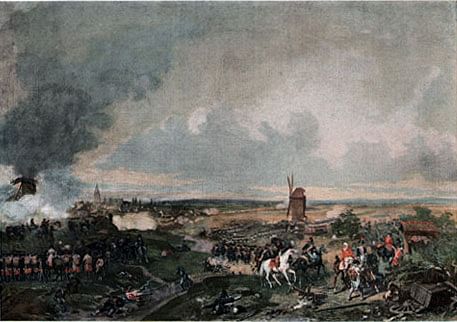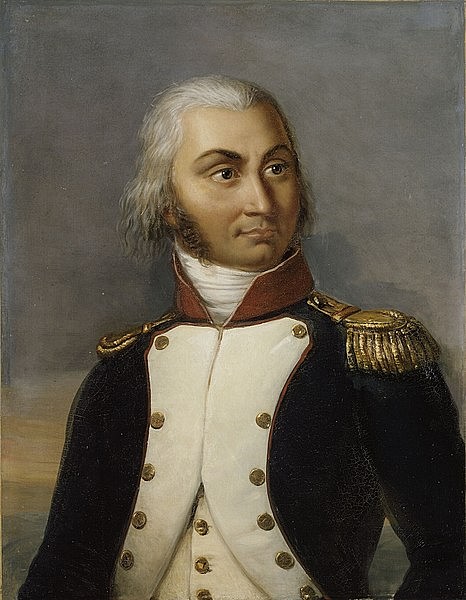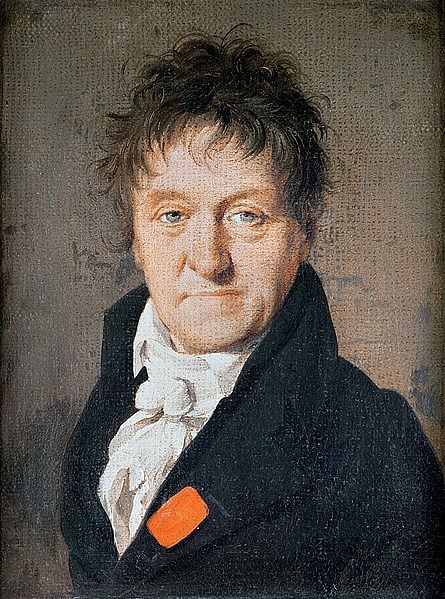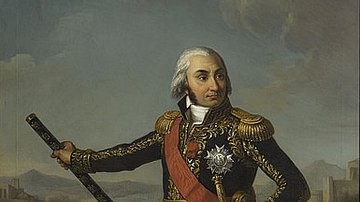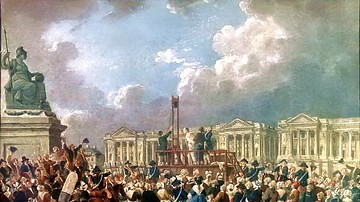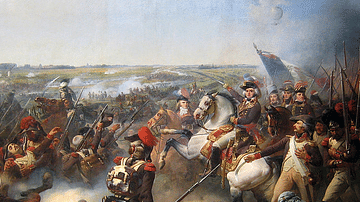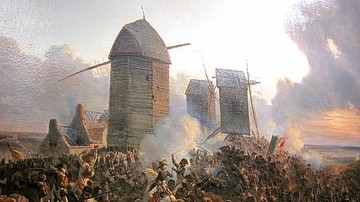The Battle of Wattignies was a significant battle in the War of the First Coalition, part of the wider French Revolutionary Wars (1792-1802). It was fought on 15-16 October 1793 between a ragtag army of the First French Republic and a professional army of the Coalition. A French victory, the battle hindered the Coalition's encroachment onto French soil.
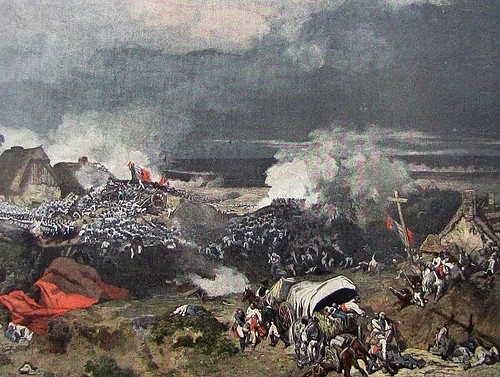
The battle was the capstone in a trilogy of French victories during the Flanders Campaign of 1792-1795, in which the French defeated the Coalition armies piecemeal; they defeated the British on 6-8 September at the Battle of Hondschoote and then beat the Dutch at the Battle of Menin on 13 September. Wattignies, fought against a mostly Austrian force, solidified the victories gained in the previous battles, weakening Coalition presence in Flanders and ensuring the survival of the French Revolution (1789-1799) for another year.
Background
The First Coalition was an alliance of Europe's great powers, united against the French Revolution. Unnerved by the trial and execution of Louis XVI and by the revolutionaries' promise to spread their revolution into the corners of Europe, the rulers of Europe's Ancien Régimes had assembled a multinational army to kill the infant French Republic in its cradle. Commanded by the Austrian nobleman Prince Josias of Saxe-Coburg-Saalfeld, this army numbered over 100,000 men at its peak, comprised of soldiers from Austria, Prussia, Great Britain, Hanover, Hessen-Cassel, and the Dutch Republic. Sweeping the French out of Belgium in March 1793, this massive army laid siege to the French fortifications near the French-Belgian border, taking Condé-sur-l'Escaut and Valenciennes in July. With the French Army of the North still in disarray after a second defeat at the Battle of Raismes, it seemed to most observers that the Coalition was within arm's reach of victory.
Yet in August 1793, the mighty allied host split in two. After Valenciennes fell to the Coalition, the British contingents received orders from the government of Prime Minister William Pitt the Younger, instructing them to capture the port city of Dunkirk with all haste. Over protests from Coburg himself, Prince Frederick, Duke of York and Albany, commander of the British army, dutifully peeled his 35,000 men off from the main army and marched westwards to Dunkirk. Coburg, determined to finish capturing the French border fortifications, turned his 45,000 Austrians in the opposite direction, laying siege to Le Quesnoy, while detachments of Dutch soldiers maintained a thin line of communication between the British and Austrian armies. Many military historians consider this move to be a massive blunder that might have cost the Coalition victory.
Meanwhile, France was busy reorganizing itself. While the Coalition was preoccupied with the border fortifications, the Committee of Public Safety, France's de facto executive government, prioritized the defense of the Republic. Implementing the Reign of Terror to uncover counter-revolutionary enemies and foreign spies, the Committee purged the armies of officers suspected of disloyalty. Scores of generals and officers were carted off to Paris where they were arrested, tried, and in some cases, executed. Meanwhile, the Committee applied a policy of mass conscription, the levée en masse, which allowed France to field 14 armies and 800,000 soldiers by year's end. By September, these policies had the effect of swelling France's armies with undisciplined, untrained conscripts commanded by officers reluctant to act against the orders of the representatives-on-mission, lest they find themselves without heads. The effectiveness of these reforms was yet to be seen.
Battles of Hondschoote & Menin
When the Coalition army split itself up, the French did not waste the opportunity. The commander of the French Army of the North, Comte de Custine, had recently been guillotined for his inaction, meaning the first order of business was to appoint a successor. The position was filled by the hapless general Jean-Nicolas Houchard, who was immediately instructed to relieve the Siege of Dunkirk and "hurl the English into the sea" (Palmer, 94). Houchard was spurred on by the Jacobin representatives from Paris who, despite being civilians, exerted complete authority over the generals, and who told Houchard to attack York's army at once. The ensuing Battle of Hondschoote, fought on 6 and 8 September, was messy and chaotic, yet resulted in a much-needed victory for the French. Caught off guard, York was forced to abandon the siege and withdraw to Furnes.
Following his victory, Houchard ignored orders from the representatives-on-mission to press on and destroy York's army. Instead, he turned toward Menin, where a 13,000-man Dutch army was left exposed by York's retreat. The Battle of Menin, fought on 13 September, was another French victory, and a humiliation for the Coalition. Dutch casualties included 5 generals (including the teenaged Prince Frederik of Orange-Nassau, son of the Dutch stadtholder, who was wounded), 88 officers, 3,000 men, and 40 cannons; French losses were comparatively light.
The remnants of the Dutch army fled to Courtrai, leaving Menin to the French; the French now controlled the road between the British at Furnes and the Austrians at Le Quesnoy. The frustrated Duke of York blamed his Dutch allies for the setback, ignoring his own part in the defeat; in a letter to his father, King George III, York wrote, "Our good friends the Dutch have again behaved with their usual cowardice" (Brown, 113). Such sentiment exemplified the mutual distrust between the nations of the Coalition that impeded their unity.
Jourdan Takes Command
Houchard led his victorious French army to Courtrai, hoping to reoccupy the town from the Coalition. When he arrived, he found that it was well-defended by an entrenched Austrian force. The French were beaten back, only to find that Menin had been recaptured by York in their absence. Rather than engage the British, Houchard retreated to Lille to regroup. He was arrested there at the end of September; despite Houchard's recent successes, the Committee of Public Safety had grown frustrated with his inability to follow up on his victories. Like his predecessor Custine, Houchard was carted off to Paris where he was charged with cowardice and treason and ultimately guillotined on 15 November.
Command of the all-important Army of the North was then offered to the 31-year-old General Jean-Baptiste Jourdan (1762-1833), who had been recovering from a wound sustained at Hondschoote. The Committee chose Jourdan because he was a commoner who owed his career entirely to the Republic, having been only a private before the Revolution. Jourdan was understandably anxious about taking command of an army that numbered over 100,000 men. He arrived at the army's camp at Gavrelle on 25 September, where he attempted to refuse the command, citing his lack of experience. The Jacobin representatives attached to the army warned Jourdan that such a refusal might result in arrest, since a recent decree ordered the arrest of any citizen who refused a job assigned to him. Reluctantly, Jourdan accepted the command.
The army he inherited was in a confused state of disrepair. Much of Houchard's staff had been arrested along with him, leaving Jourdan with a bureaucratic mess. The army was so disorganized that it was unclear which generals managed which divisions, with some units deprived of most of their officers by the recent arrests. The influx of conscripts meant Jourdan also had to deal with thousands of untrained, undisciplined men, most of whom lacked adequate clothing, weapons, and footwear; around three-quarters of Jourdan's soldiers were barefoot. The army also lacked horses to haul artillery, and military purchasers had to compete with the Commune of Paris for the limited food supplies.
Jourdan had no choice but to write to Paris for help. In early October, minister of war Lazare Carnot (1753-1823) arrived and observed for himself that Jourdan had not been exaggerating. Using his influence, Carnot was able to procure rifles, horses, food, and 8,000 pairs of shoes from Paris and the surrounding towns. While Jourdan was undoubtedly grateful for Carnot's help, he may have become disheartened when it became clear that Carnot had no intention of returning to Paris. Instead, Carnot insisted that Jourdan march to defeat the Austrians, who had begun the siege of Maubeuge. Cognizant of the fates of his predecessors, Jourdan did not dare refuse.
Siege of Maubeuge
On 13 September, Le Quesnoy fell to the Austrians. The Prince of Coburg then laid siege to Maubeuge, yet another fortified town 11 miles south of Mons. The French Republic could not allow Maubeuge to fall; if it did, Coburg would control four French fortifications, giving him a base of operations on French soil from where he could launch attacks deeper into the interior. Coburg besieged the city itself with 26,000 men, comprised of 10,000 Austrians and 16,000 Dutch commanded by the stadtholder himself, William V, Prince of Orange. The covering force, commanded by Count Clerfayt, consisted of 37,000 men. It was posted south of Maubeuge, running from Wattignies on the far left to Monceau-Saint-Waast on the right, a line about 8 miles (13 km) long.
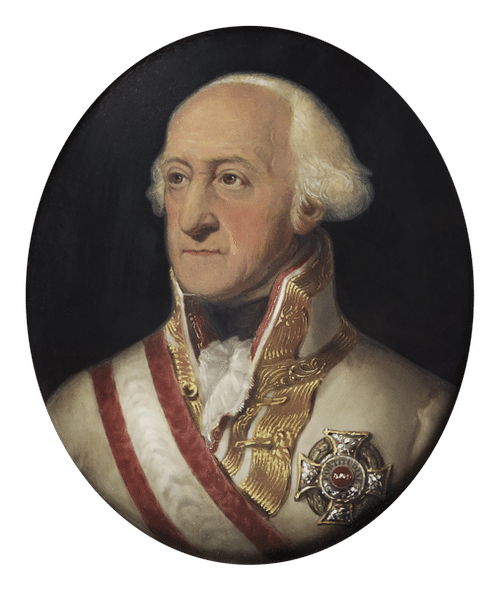
Eager to rejoin all the Coalition forces, Coburg wrote to York and urged him to join the siege of Maubeuge with all haste. York did his best to comply, but his army was ravaged by disease and would not make it in time for the coming battle. Meanwhile, Coburg built extensive siege works around the city and began putting pressure on the 17,000 French defenders. On the first day of the siege, the defenders sortied against the Coalition but were repulsed after heavy fighting. By 10 October, the garrison was put on half-rations as sick and dying men crowded the hospitals. Coburg got his artillery into place and commenced the shelling of the town on 14 October. The town might have quickly fallen, had Jourdan's Army of the North not shown up that same day.
Jourdan commanded some 45,000 battle-ready soldiers, having kept the more inexperienced half of his army back. Still, he outnumbered Clerfayt's covering army, which was extended so thinly that Clerfayt could realistically only utilize 21,000 of his men. Despite this numerical disadvantage, Coburg himself was unworried. On the eve of the battle, he joked to his officers that if he lost the coming fight, he would give up his noble titles and become a sans-culotte. The French soldiers were greatly amused when word of this joke reached their camp, and immediately began to make a pair of trousers to present to the prince when he inevitably lost. Spirits were high in Jourdan's army, especially when news reached them of the Republic's victory over the Revolt of Lyon a few days prior.
First Day: 15 October
The morning of 15 October found the Austrian army entrenched, awaiting the French attack. Although Clerfayt was nominally in command, Coburg decided to take control of the battle personally. He wrote to the Prince of Orange to ask for reinforcements, but the Dutch stadtholder refused to move his soldiers away from Maubeuge, fearful that another sortie by the French garrison would be disastrous if no one stayed behind to keep them contained. It turned out that the garrison of Maubeuge would play no part in the fighting, as its commander became convinced that the fighting was just a trick to lure them out and take the city. But before the battle, both sides assumed the garrison would aid Jourdan's attack.
Jourdan began the battle with a dual assault against the Austrian flanks. On the French right, two divisions under generals Duquesnoy and Beauregard set off at 7 a.m., their target being the end of the Austrian line at Wattignies itself. Simultaneously, a French division under Jacques Fromentin advanced on the left. Problems arose from the start. According to historian Ramsay Weston Phipps, Beauregard's division were "bad troops under a bad general", who fled at the first sight of Austrian cavalry upon reaching the town of Obrechies (256). Their rout left 5 cannons to be taken by the Austrians and left the flank of Duquesnoy's division exposed.
Despite the loss of Beauregard's supporting division, Duquesnoy managed to make it all the way to Wattignies. Supported by cannon fire, he chased off two Austrian battalions and began to occupy the town; as he moved his division in, his men were surprised by a fierce Austrian counterattack. This sent Duquesnoy's men running, and the Austrians once again controlled the town. On the French left flank, Fromentin's division ended up in a ravine, grappling with a Croatian infantry battalion for control of the village of Saint-Aubin. When the Austrians sent in reinforcements, Fromentin was forced to withdraw, abandoning eight cannons.
Meanwhile, Jourdan had positioned his center in the woodlands, preparing to charge them in as soon as he could be certain the flank attacks succeeded. As the morning wore on, Jourdan was told of the moderate progress the flank attacks had made so far. Carnot urged Jourdan to attack immediately, warning that it was not the time for caution. Jourdan believed it was too early for an attack, but ordered one anyway, personally leading the charge against the enemy center.
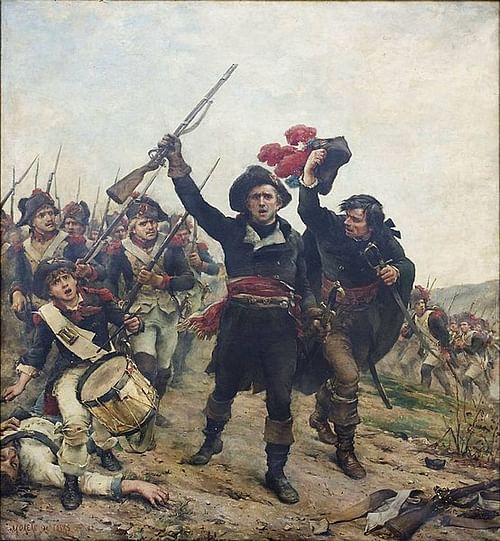
The Austrian center, commanded by Clerfayt himself, was dug in along the sunken Monceau road, and consisted of five hardened grenadier battalions, supported by regiments of French émigrés and Croatians. As soon as the French Republican soldiers were spotted cresting the hill, the Austrians let loose volley after volley of rifle fire. The French charge became bogged down, and the attack quickly became a slaughter. Jourdan's attempts to unlimber his cannons failed, as the French artillery gunners were targeted by Austrian sharpshooters. When Austrian reinforcements arrived, Jourdan ordered a retreat. 1,500 French had become casualties in the attack on the Austrian center alone.
Second Day: 16 October
On the morning of the second day, 16 October, Jourdan decided to focus the brunt of his attack on Wattignies; Carnot would later claim credit for this plan, but many military historians credit it to Jourdan himself. While Fromentin's division was ordered to simply distract the Austrian right and center with skirmishers, 22,000 French were to advance against the Austrian left in three columns. A thick fog covered the field until 9 a.m., but once it lifted, the French began an incessant artillery bombardment of Wattignies.
Twice the French charged the town, and twice they were driven back by heavy Austrian fire. Yet with each assault, the defenders buckled further; when the French charged a third time, the Austrians broke under the sheer weight of numbers. By nightfall, the French controlled Wattignies and dug in, expecting a Coalition counterattack the next morning. Such an attack never came; still wary of the 17,000 French troops inside Maubeuge, Coburg decided to cut his losses. He lifted the siege and withdrew across the Sambre river to find winter quarters for his army. Austrian casualties for the battle were 365 killed, 1,753 wounded, and 369 missing. French losses were substantially higher, between 3,000-5,000 men.
Aftermath
Jourdan was shocked to learn that he had won the battle; on the night of 16 October, he had written Paris that he believed the battle would result in a stalemate. On 17 October, the French marched triumphantly into Maubeuge, only to find a weary population who did not seem overly joyous to be liberated. Carnot reported to his colleagues on the Committee of Public Safety, "the citizens of Maubeuge have not received us with the transports which it seems they should manifest toward their liberators…we must work to electrify these regions a little and rebuild public spirit" (Palmer, 102-3). This was, of course, a recommendation to bring the Terror to Maubeuge.
The victory at Wattignies was celebrated throughout France, and the town itself was even renamed Wattignies-la-Victoire. It was more of a propagandic than a strategic success; neither Coburg nor York were knocked out of the war, their armies still representing a threat. Yet the battle was celebrated as a second Valmy, and Carnot and Jourdan each wrote to Paris praising one another's conducts. This mutual admiration would soon fall apart when Jourdan refused an order from the Committee of Public Safety to retake the forts occupied by Coburg; it was too close to winter, Jourdan argued, and his army was not adequately supplied. The general asked to be allowed to make winter quarters instead, telling the Committee he would not lead his men to butchery.
The Committee begrudgingly agreed, and the Army of the North went into winter quarters, ending the year's campaign season. But when Jourdan refused another order to send 15,000 men to fight Vendean rebels (Jourdan claimed he had no men to spare), the Committee's patience ran out. In late December, Jourdan was summoned to Paris to 'talk' with the Committee; upon arrival, he was stripped of his command and arrested on 10 January 1794. The arrest warrant had been written by Carnot himself, who by now had begun to take sole credit for Wattignies.
Luckily, a representative-on-mission spoke up in Jourdan's defense, speaking to his valiant conduct. For this reason, Jourdan avoided the fates of his predecessors and was spared an unpleasant date with Madame Guillotine. Instead, he was given a pension and forced into retirement. This retirement would not last long; soon, Jourdan would be back in command and would lead the French Republic to another, even greater victory at the Battle of Fleurus on 26 June 1794. Fleurus would be the most significant battle of the Flanders Campaign; afterwards, the French would remain victorious for the rest of the war.

